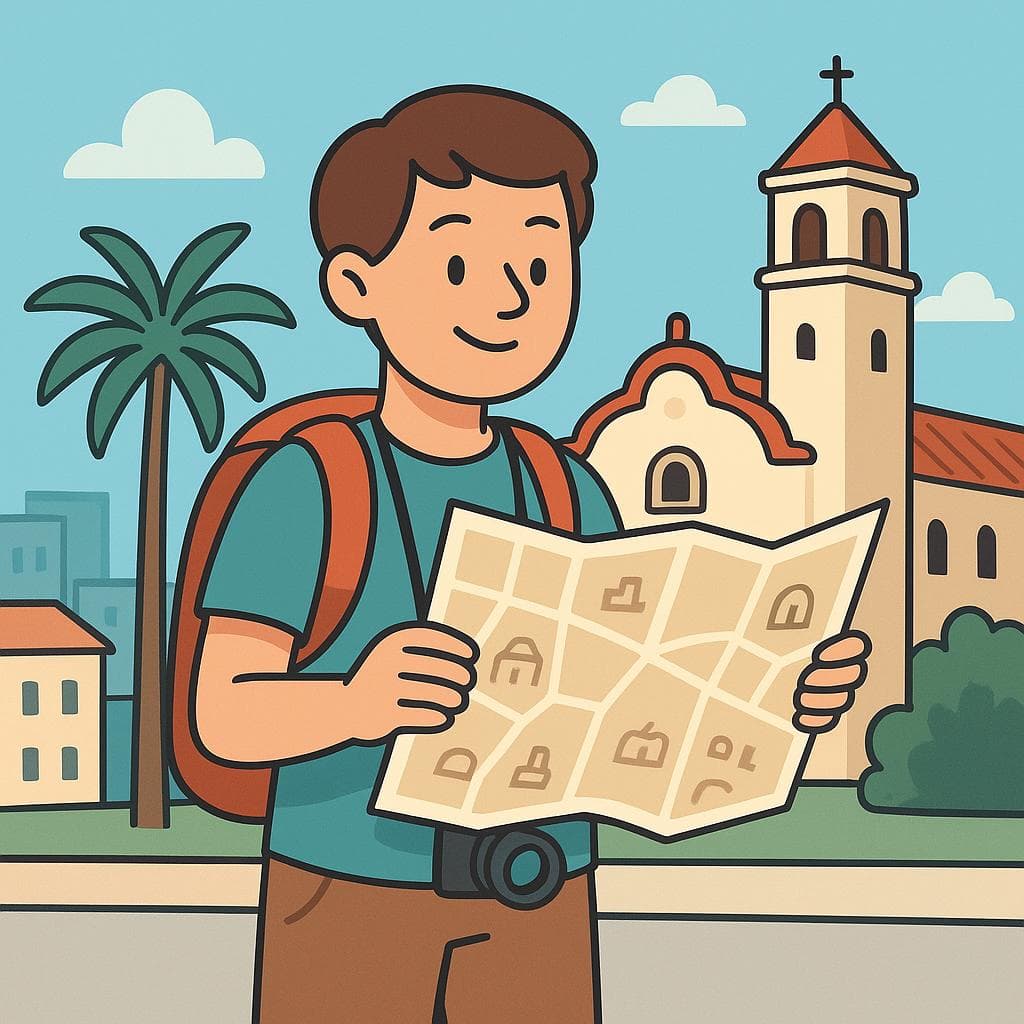I am a tourist
in SpanishSoy turista.
/soy too-REES-tah/
This is the most direct, common, and universally understood way to say 'I am a tourist.' It works in virtually any context, from talking to an immigration officer to a friendly local on the street.

Knowing how to say 'Soy turista' can help you get directions or friendly assistance when exploring a new place.
💬Other Ways to Say It
Soy un/una turista.
/soy oon/OO-nah too-REES-tah/
This version includes the article 'un' (for a male) or 'una' (for a female). It's just as common as 'Soy turista' and is slightly more grammatically complete, though both are perfectly correct.
Estoy de turista.
/ehs-TOY deh too-REES-tah/
This variation emphasizes that being a tourist is your current activity or state. It translates more like 'I'm here as a tourist' or 'I'm touristing.'
Estoy de visita.
/ehs-TOY deh bee-SEE-tah/
A slightly broader and very polite alternative, meaning 'I am visiting.' It's a soft and friendly way to explain your presence without explicitly using the word 'tourist.'
Estoy de vacaciones.
/ehs-TOY deh bah-kah-SYOH-nes/
This means 'I am on vacation.' It's an extremely common way to explain your purpose for being somewhere and often implies you're a tourist.
Ando de turista.
/AHN-doh deh too-REES-tah/
A more colloquial and dynamic phrase, translating to 'I'm going around as a tourist.' The verb 'andar' implies movement and activity.
🔑Key Words
Key Words to learn:
📊Quick Comparison
Here’s a quick comparison of the most common ways to say you're a tourist to help you choose the best one for your situation.
| Phrase | Formality | Best For | Avoid When |
|---|---|---|---|
| Soy turista. | Neutral | General purpose statements of identity, like at customs or when asking for help. | It's almost never wrong, but 'Estoy de visita' can sometimes sound softer. |
| Estoy de turista. | Neutral | Explaining your current activity, like why you're taking photos or looking at a map. | In very formal situations like immigration, where 'Soy turista' is more direct. |
| Estoy de visita. | Neutral/Polite | Sounding friendly and polite, or when you're in a less touristy area. | If you specifically need to emphasize that you are a tourist for a discount or entry. |
| Estoy de vacaciones. | Neutral | Casual conversations about your trip, emphasizing leisure and relaxation. | Business trips or if the context isn't about a holiday. |
📈Difficulty Level
Fairly easy for English speakers. The main challenge is the soft, slightly rolled 'r' in 'turista,' but it will be understood even if you use an English 'r'.
The main grammatical hurdle is knowing to use 'Soy' (from Ser) instead of 'Estoy' (from Estar). Once you learn that rule for this context, it's very simple.
The phrase is straightforward, but being aware of when it might attract unwanted attention versus genuine help is a minor cultural nuance.
Key Challenges:
- Remembering to use 'soy' instead of 'estoy'
- Matching the gender for 'un/una turista'
💡Examples in Action
Disculpe, estoy un poco perdido. Soy turista. ¿Dónde está la catedral?
Excuse me, I'm a little lost. I am a tourist. Where is the cathedral?
Oficial: ¿Cuál es el motivo de su viaje? Viajero: Vengo de vacaciones. Soy una turista.
Officer: What is the purpose of your trip? Traveler: I'm coming for vacation. I am a tourist.
La gente de aquí es muy amable. Me preguntan si necesito ayuda porque ven que estoy de turista.
The people here are very kind. They ask me if I need help because they see that I'm here as a tourist.
No, gracias. No quiero comprar nada, solo estoy de visita.
No, thank you. I don't want to buy anything, I'm just visiting.
🌍Cultural Context
A Useful 'Get Out of Jail Free' Card
Saying 'Soy turista' is a friendly way to signal that you might not know local customs, speak the language perfectly, or understand how things work. People are often more patient and willing to help once they know you're a visitor.
Tourist vs. Traveler (Turista vs. Viajero)
Just like in English, some people prefer to be called a 'viajero/a' (traveler) instead of a 'turista' (tourist), as the latter can sometimes have a slightly negative image of being loud or disconnected from the local culture. However, for practical purposes, 'turista' is perfectly fine and universally understood.
A Double-Edged Sword
While identifying yourself as a tourist can bring help, be aware that in heavily touristed areas, it can also make you a target for scams, pickpockets, or persistent street vendors. It's good to be mindful of your surroundings when you use this phrase.
❌ Common Pitfalls
Using 'Estar' Instead of 'Ser'
Mistake: "Estoy turista."
Correction: Soy turista.
Forgetting Gender with 'Un/Una'
Mistake: "A woman saying 'Soy un turista.'"
Correction: Soy una turista.
Adding an Unnecessary 'Yo'
Mistake: "Yo soy turista."
Correction: Soy turista.
💡Pro Tips
Your Go-To for Getting Help
Pair this phrase with a request for help to immediately give context. For example: 'Disculpe, soy turista. ¿Me puede ayudar?' (Excuse me, I'm a tourist. Can you help me?). This is a very effective combination.
Choose 'Soy' or 'Estoy de' Based on Focus
Use 'Soy turista' to state your identity or role. Use 'Estoy de turista' or 'Estoy de visita' to describe your current activity or the reason you are in a particular place at that moment.
A Polite Way to Decline
If a persistent vendor is trying to sell you something, a simple 'No, gracias, soy turista' or 'Solo estoy mirando, gracias' (I'm just looking, thanks) can be a polite way to disengage.
🗺️Regional Variations
Spain
The term 'guiri' is unique to Spain and is used informally to refer to foreign tourists, especially those from Northern Europe or the US. It can be affectionate or slightly pejorative depending on the context, so it's best for learners to avoid using it themselves.
Mexico
The use of 'andar' in 'Ando de turista' is very common and sounds very natural in Mexico. It adds a sense of being actively engaged in exploring, making it a friendly and dynamic alternative in casual chats.
Argentina
The pronunciation is the most notable difference. The intonation is also very melodic and Italian-influenced. The vocabulary for travel is largely the same as in other regions for this basic phrase.
💬What Comes Next?
After you say you're a tourist
¿De dónde eres?
Where are you from?
Soy de [Your Country].
I'm from [Your Country].
They are curious about your trip
¿Cuánto tiempo te quedas?
How long are you staying?
Me quedo [number] días/semanas.
I'm staying for [number] days/weeks.
They want to offer assistance
¿Necesitas ayuda?
Do you need help?
Sí, por favor. Busco el museo.
Yes, please. I'm looking for the museum.
🧠Memory Tricks
The rhyme connects 'soy' with 'sights' and the '-a' at the end of 'turista' helps you remember the sound of the word.
🔄How It Differs from English
The biggest difference is the use of 'ser' vs. 'estar'. In English, 'I am' covers identity, location, and condition. In Spanish, you must choose. 'Soy turista' defines your role/identity, while 'Estoy de turista' describes your current state/activity. This distinction doesn't exist in English and is a core concept in Spanish.
🎯Your Learning Path
➡️ Learn Next:
Estoy perdido/a.
This is a common situation for a tourist, and it's the natural next step after explaining who you are.
¿Dónde está el baño?
One of the most essential travel phrases you'll need after identifying yourself as a visitor.
¿Me puede ayudar, por favor?
This is the perfect way to politely ask for assistance after stating that you are a tourist.
Soy de...
This is the most common follow-up question you will receive after saying you are a tourist.
✏️Test Your Knowledge
💡 Quick Quiz: I am a tourist
Question 1 of 3
You're in Madrid and a police officer asks what you're doing in a restricted area. What is the most direct and appropriate thing to say?
Frequently Asked Questions
What is the real difference between 'Soy turista' and 'Estoy de turista'?
Think of it this way: 'Soy turista' is about your identity ('I am a tourist'). 'Estoy de turista' is about your activity ('I am here as a tourist'). Both are correct and often interchangeable, but 'Soy' is more of a statement of fact, while 'Estoy de' describes what you're doing right now.
Do I need to say 'Yo soy turista'?
No, it's more natural to leave out the 'Yo' (I). The verb 'soy' already means 'I am,' so the 'Yo' is redundant. While not grammatically wrong, you'll sound more like a native speaker if you just say 'Soy turista.'
How do I say it for a man vs. a woman?
The phrase 'Soy turista' works for everyone. If you add the article 'un/una', then you must match your gender. A man says 'Soy un turista,' and a woman says 'Soy una turista.'
Is it ever a bad idea to say I'm a tourist?
Generally, it's safe and helpful. However, in crowded areas known for pickpocketing or scams, it's wise to be discreet. Instead of announcing it loudly, you can say it quietly to someone you are asking for help, like a shopkeeper or police officer.
What if I'm not really a tourist but just visiting family?
In that case, 'Estoy de visita' (I am visiting) is the perfect phrase. You can also be more specific and say 'Estoy visitando a mi familia' (I am visiting my family).
Is 'turista' pronounced 'tourist-ah' or 'turist-ah'?
The pronunciation is 'too-REES-tah'. The 'u' sound is like the 'oo' in 'food', not the 'ou' in 'tour'. The stress is on the second-to-last syllable: too-REES-tah.
📚Continue Learning Spanish Phrases
Explore More Phrases in These Categories
Find similar phrases to expand your Spanish vocabulary:
Want to Learn More Spanish Phrases?
Browse our complete collection of Spanish phrases organized by situation, from basic greetings to advanced conversations. Perfect for travelers, students, and anyone learning Spanish.
View All Spanish Phrases →


